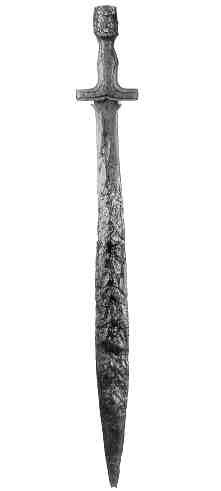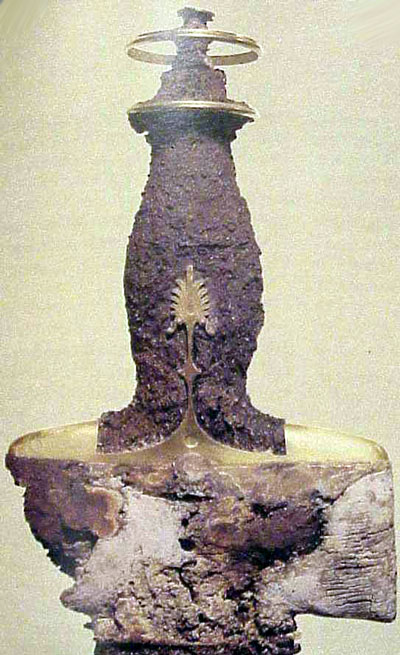| Author |
Message |
|
Lafayette C Curtis
|
 Posted: Mon 15 Jan, 2007 4:46 am Post subject: Pictures of authentic xiphoi? Posted: Mon 15 Jan, 2007 4:46 am Post subject: Pictures of authentic xiphoi? |
 |
|
Can anybody provide me with a picture of an authentic historical xiphos--and by that I mean a museum piece, not a reproduction? All the pictures I've seen so far seem to be repros and shots of the same repro at that.
Thanks beforehand!
|
|
  |
 |
|
Peter Johnsson
Industry Professional
|
 Posted: Mon 15 Jan, 2007 6:30 am Post subject: Posted: Mon 15 Jan, 2007 6:30 am Post subject: |
 |
|
How about therse two found in South Italy?
(Greek colonies)
 Attachment: 10.09 KB Attachment: 10.09 KB

 Attachment: 4 KB Attachment: 4 KB

|
|
   |
 |
|
Lafayette C Curtis
|
 Posted: Tue 16 Jan, 2007 2:07 am Post subject: Posted: Tue 16 Jan, 2007 2:07 am Post subject: |
 |
|
|
Yes, those pictures are certainly very helpful. Thanks a lot!
|
|
  |
 |
Kirk Lee Spencer

|
 Posted: Tue 16 Jan, 2007 7:52 am Post subject: Posted: Tue 16 Jan, 2007 7:52 am Post subject: |
 |
|
Here is a picture of the hilt of a sword believed by some to be that of Phillip II of Macedon (Alexander the Great's father). It was found in a large tumulus burial near the site of Phillip's royal city (Vergena?)
ks
 Attachment: 81.94 KB Attachment: 81.94 KB

Two swords
Lit in Edens flame
One of iron and one of ink
To place within a bloody hand
One of God or one of man
Our souls to one of
Two eternities
|
|
  |
 |
|
Lafayette C Curtis
|
 Posted: Tue 16 Jan, 2007 8:06 am Post subject: Posted: Tue 16 Jan, 2007 8:06 am Post subject: |
 |
|
|
Ouch. That last one made me wonder about how the degradable components would have looked like if they had not been eaten away by rot and rust.
|
|
  |
 |
|
Peter Johnsson
Industry Professional
|
 Posted: Tue 16 Jan, 2007 10:36 am Post subject: Posted: Tue 16 Jan, 2007 10:36 am Post subject: |
 |
|
| Lafayette C Curtis wrote: | | Ouch. That last one made me wonder about how the degradable components would have looked like if they had not been eaten away by rot and rust. |
Yes...
Note the large block of ivory that forms the mouth of the scabbard. This is a feature you can often see in vase painitngs: a rather massive looking mounting that seems to fit the guard with some kind of countersinking.
The same can be seen on Italic (and other?) bronze age scabbards. The mouth of the scabbard was shaped to fit the guard of the sword.
My impression is that this was a sort of inverted rain guard, mounted on the scabbard and not the guard of the sword.
The first sword I posted deos not seem to have this feature so well developed however.
I have only handled one single Xiphos personally. It is kept in the store room of the Historical Museum in Stockholm. A slim leaf shaped blade with diamond cross section. The grip was most probably a contemporary replacement (even if it was made to look ancient) and the guard might have been taken from another sword. Difficult to say. Could have been original.
The guard was interesting in that it was made from four different pieces of bronze. Two plates back and front were fastened at the ends to small solid bronze blocks that had lion heads facing outwards. There was a gap between the plates and the tang where the grip scales would have fitted. There were no metal bands reinforcing the grip on this one, but the grip was most probably modern any way. There was no pommel: the modern grip extended into something somewhat pommel shaped.
The blade was about 60 cm long, slim but not too thin. The rust can have made the blade grow thicker, but my impression was that this sword had always been pretty stiff. As it flared out before the point it could have been some 4 cm wide. At the base perhaps 5 -6 cm. At the narrow waist it would have been about 3,5 cm.
Some Xiphoi were shorter, only about 50 cm long in the blade, or shorter still. Others were longer, up till around 70 cm. Some were quite slim, while others were broader. There was also quite some variation to the amount of waisting.
Cross sections could be lenticular, diamond shaped, ribbed or hollowground. There might have been decorative grooves in some examples as well.
|
|
   |
 |
|
Lafayette C Curtis
|
 Posted: Wed 17 Jan, 2007 6:07 am Post subject: Posted: Wed 17 Jan, 2007 6:07 am Post subject: |
 |
|
|
That's definitely a bunch of interesting information. Did you get the chance to swing it or use it in any other way, BTW?
|
|
  |
 |
|
Peter Johnsson
Industry Professional
|
 Posted: Wed 17 Jan, 2007 8:56 am Post subject: Posted: Wed 17 Jan, 2007 8:56 am Post subject: |
 |
|
Not possible.
It was as solid and recilient as a length of ginger bread: mostly just rust. Great care was needed just to lift it from its bed of styrofoam. I was lucky to be allowed to do this, I guess. You donīt want a thing like this snapping in two as you handle it...
Still, it was possible to get a pretty good idea of what one of these swords would have been just by holding it in your and and feeling the overall size and physical character.
| Lafayette C Curtis wrote: | | That's definitely a bunch of interesting information. Did you get the chance to swing it or use it in any other way, BTW? |
|
|
   |
 |
|
Lafayette C Curtis
|
 Posted: Wed 17 Jan, 2007 9:47 am Post subject: Posted: Wed 17 Jan, 2007 9:47 am Post subject: |
 |
|
|
Ouch. It's frightening to see what age can do to what was once such a formidable weapon.
|
|
  |
 |
|
George H.
|
 Posted: Fri 19 Jan, 2007 11:32 am Post subject: Posted: Fri 19 Jan, 2007 11:32 am Post subject: |
 |
|
|
I recall seeing on some site where supposedly there was an attested example of an ancient xiphos with a cast metal handle. Anyone know anything about that?
|
|
  |
 |
|
|

